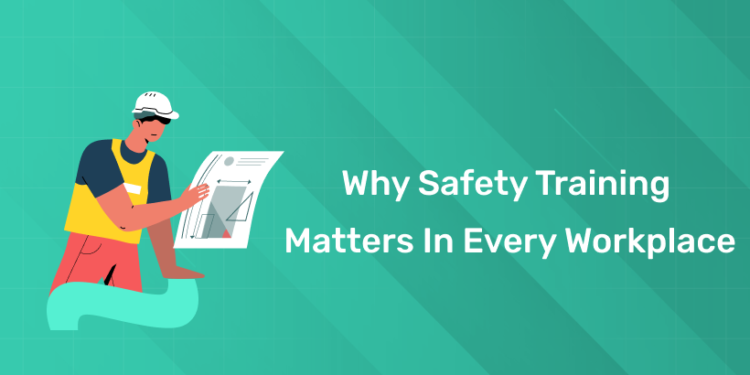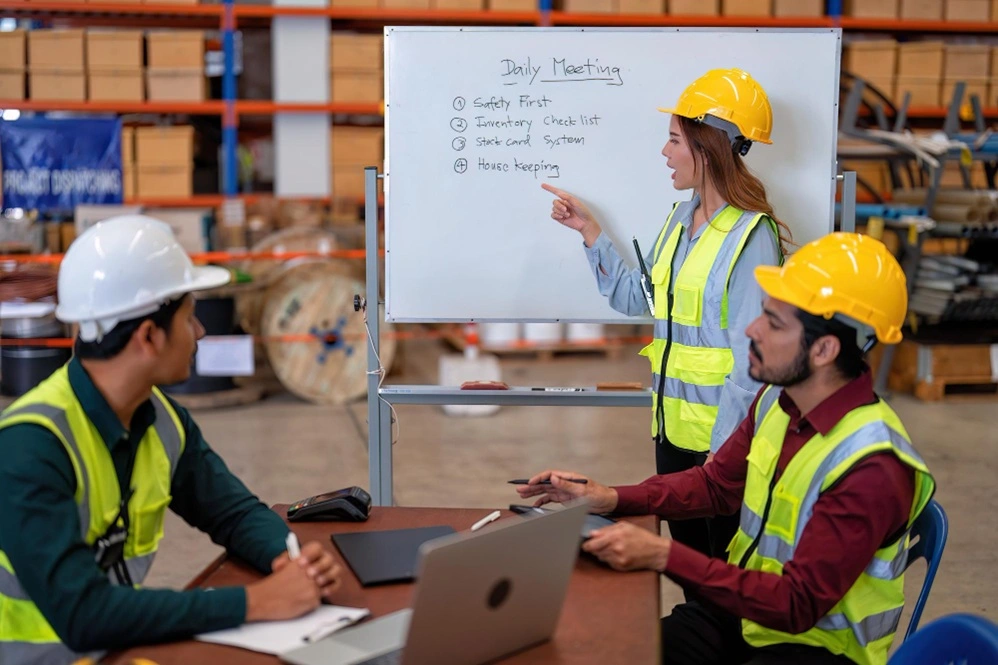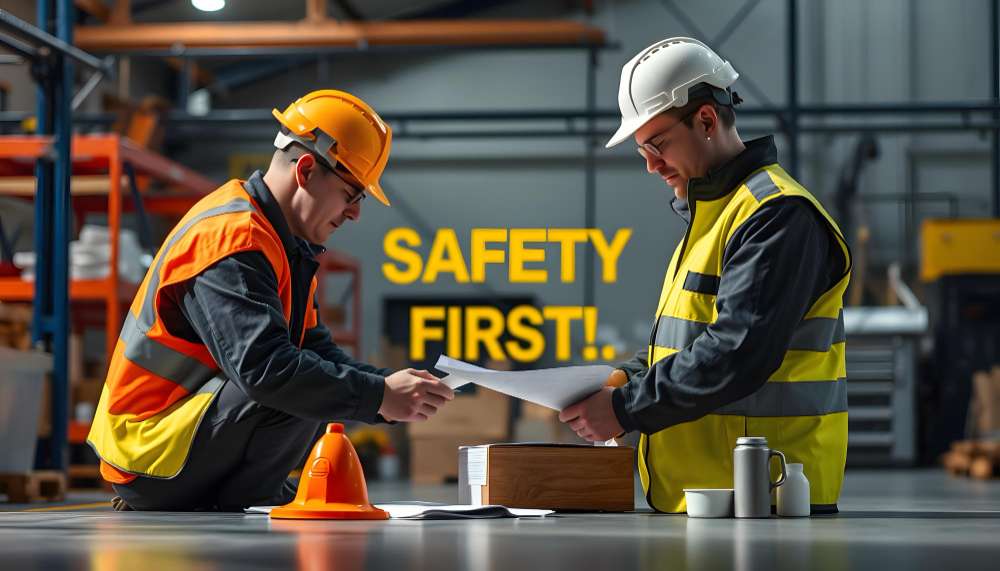Table of Contents
In every single sector – from Indian factories churning out goods, to Gulf construction sites plodding along, – safety training is the cornerstone on which a productive, involved and resilient workforce gets built. But fast forward to 2025 and safety training is about so much more than just filing all the right forms; its about actually investing in the people who do the work, your business’s reputation, keeping the show on the road, and helping your country grow.
If you’re an engineering student, a site foreman trying to keep a tight ship, or a safety officer doing their best, then getting a handle on the importance of workplace safety training is crucial – not just to keep the auditors at bay but to keep your mates safe, advance your career and make sure you’ve got a job next year.
Understanding Safety Training: More Than Legal Compliance
Safety training gives ordinary folk the skills they need to spot potential dangers, follow the right procedures, put the right gear on, and get to work fast in an emergency. Today’s top-class safety training covers all angles: how to use the machinery, how to store chemicals, the right way to use your body at work, all the ins and outs of electrical procedures, how to do a fire drill, taking care of your mental health, keeping your digital self secure – the list goes on and on.
But its not just about being able to rattle off a list of rules; its about actually getting a culture of safety going, so that every individual automatically looks out for themselves and their mates.
The Critical Need for Stronger Safety Training
- Rising complexity and automation mean more technical risks. New tools, robotics, and AI-powered systems require specialized safety protocols matched to emerging workplace hazards.
- Tougher global safety regulations and audits. Countries like India, UAE, the EU, and the USA are enforcing stricter workplace safety laws, holding both companies and individuals accountable.
- Changing workforce demographics. Younger employees and contract staff often lack experience, leading to higher accident rates unless proper onboarding and “toolbox talks” are delivered regularly.
- Remote and hybrid work add unique risks. Ergonomics, home office hazards, and digital security now require dedicated training.
Hard-Hitting Facts: The Impact of Safety Training
Reduces Workplace Injuries and Deaths
- Companies with structured safety programs reduced injuries by up to 50%.
- Construction sites where trained workers saw 35% fewer accidents six months after sessions compared to before.
- Workers with regulated safety training are twice as likely to use PPE correctly and comply with protocols.
Boosts Financial Health and Cuts Hidden Costs
- $4–$6 saved for every $1 invested in safety training programs, thanks to fewer injury claims and insurance premium reductions.
- Untrained workers cost businesses millions annually in lost productivity, legal penalties, and compensation payouts.
- OSHA and government penalties range from ₹1 lakh to ₹1 crore per violation, not counting indirect costs (e.g., reputation loss).
Enhances Employee Morale, Retention, and Efficiency
- 92% of workers say safety training positively impacted their job engagement and confidence.
- High-engagement teams show 17% higher productivity and 21% more profitability than teams with poor training.
- 80% of employees prefer staying with an employer who invests in their skills and safety.
Core Objectives of Safety Training
A really successful safety training program should have a clear focus on four key goals :
Awareness
To get this right, employees need to get their heads around potential hazards – that’s everything from dodgy machinery and dodgy chemicals to making sure the workplace isn’t going to make them all ill or anything.
Preventing the Worst
Safety training gives staff the tools and the knowledge to put safety controls in place, so we’re all a lot less likely to get hurt.
Staying on the Right Side of the Law
Playing by the local and international rules means we avoid getting sued and any workplace shutdowns that would come with it.
A Good Safety Culture
Getting the whole team on board with safety is what it’s all about – it’s about employees taking responsibility for their own safety and the safety of their mates.
Types of Safety Training – What We See
General Safety Orientation – Getting Newbies Up to Speed
A simple induction program that new employees need to go through – covering all the basic workplace rules, how to handle an emergency and the like.
Job-Specific Training – What You Need to Know
The people with the technical jobs – they need training that’s relevant to the job , so for instance:
- Engineers: You need to know how to use the machinery safely, handle chemicals without poisoning yourself and all that jazz.
- Technicians: They need to know how to keep the kit running, how to use the right gear and how to follow the rules.
Fire and Emergency Response
How to stop fires from starting, how to put them out, how to evacuate the place without getting trampled and all that first response type of stuff.
First Aid and Ergonomics – Basic Life Skills
CPR, proper posture to stop your back going on you and all the rest of it – these are the kind of skills you need to stay alive on the job.
Using PPE – Safety Gear 101
Just making sure that everyone knows how to use protective gear like helmets, gloves, safety goggles and high-visibility clothing properly so we all go home safely at the end of the day.
What Does Quality Safety Training Look Like?
- Industry-Specific and Practical
- Training must match the unique hazards and workflows of your sector, whether oil & gas, IT labs, healthcare, or manufacturing.
- Example: A power plant engineer receives electrical lockout/tagout training; a hotel worker gets fire evacuation and chemical spill drills.
- Ongoing, Not Just Once a Year
- Safety is dynamic. As processes, teams, and regulations change, so should your training. The most resilient companies invest in ongoing sessions, digital micro-learning, and regular “toolbox talks.”
- Interactive, Real-World Scenarios
- Passive video watching leads to forgetfulness. The best results come from hands-on demonstrations, peer discussions, and working through real-life incidents.
- Site simulations, mock evacuations, and equipment handling drive home “muscle memory” responses in emergencies.
- Inclusive and Culturally Sensitive
- Effective training uses the local language, addresses diverse backgrounds, recognizes literacy levels, and makes sure everyone feels empowered to speak up.
- Covers All Aspects, Physical, Mental, and Digital
- In the modern workplace, safety goes beyond slips, trips, and falls. Stress management, mental wellbeing, and even online privacy are core to holistic safety training.
Geo-Targeted Insights: The Indian & Gulf Context
- India:
Rapid infrastructure, IT parks, and industrial projects drive demand for certified workers. Many government tenders now require proof of safety training for site entry, driving up demand for programs like IOSH, NEBOSH, and OSHA-compliant courses. - Gulf/ UAE/ Middle East:
Strict Ministry of Labour and site regulations make contractor safety credentials mandatory for both locals and expats. Fatality rates have dropped in recent years as companies adopted more rigorous, language-accessible training.
Tips for Conducting Safety Training
To ensure safety training is impactful and outcome-driven, employers should follow these best practices:
- Tailor Training to Job Tasks: Safety training must be applicable to the work employees are performing. A warehouse worker needs different training than a construction worker, for example.
- Make it Ongoing: Safety isn’t a one-time event. Just as with earthquake safety, periodic refresher courses, drills, and updates are needed to keep workers ready for any emergency.
- Use Real-Life Scenarios: Safety training should be practical and relevant to everyday situations. By rooting your training in real-world situations, you make sure your employees can identify with the content and see how to implement it in their work life.
- Make it interactive: e-lessons, webinars and hand-on activities (fire drills) are more engaging than lectures and increase retention.
- Track and Test: Track who’s taken safety training and periodically test that employees are remembering it.
How to Make Safety Training Engaging and Effective
Because to hold employees’ interest and really educate them, safety training has to be engaging! And here’s what to do to make your safety training come alive:
- Interactive Learning: Use quizzes, hands-on demos and exercises to keep employees engaged.
- Visual Aids: Incorporate videos, infographics and illustrations to visually convey safety precautions.
- Gamification: By injecting game elements such as scoring, rewards, and competition, you can make safety training fun and memorable.
- Feedback Loops: Empower employees to offer feedback on the training experience. This allows for real-time polishing and ensures the scrimmage meets their needs.
Overcoming Barriers to Effective Safety Training
- Lack of management buy-in:
Solution: Leaders must lead by example; sharing ROI data with C-suites changes mindsets. - Language and literacy hurdles:
Solution: Use visuals, regional dialect audio aids, and peer trainers. Digital platforms like Entri offer localized, easy-to-access mobile learning. - Training fatigue:
Solution: Micro-learning, gamification, and peer recognition programs keep engagement high.
Key Takeaways
- Safety training is the most reliable, cost-effective investment an organization can make, saving lives, money, and reputations.
- Modern, interactive, and ongoing programs far outperform outdated, once-a-year lectures.
- Engineering students, safety aspirants, and working professionals who take proactive roles in safety upskilling are more employable, promotable, and respected in today’s workplace.
- The ripple effects of safety extend far beyond site gates, reaching families, communities, and national economies.
Conclusion
Safety isn’t just a regulation – it’s a way of life,a Culture that sets businesses & workers in India, the Gulf & elsewhere, apart – a real competitive edge in every industry. By putting your money into effective targeted safety training, companies & workers are building a future where everyone goes home to their loved ones safe, every single day.
Ready to make your workplace a safer, more successful place? Start with your own ongoing safety training & get your team on board too – trust us, it’ll pay off in more ways than you think!
Frequently Asked Questions
How often should workplace safety training be conducted?
Ideally, safety training should be ongoing, at orientation, during regular refreshers, and whenever processes, equipment, or teams change.
Does safety training benefit only high-risk industries?
No. Offices, schools, retail, and even IT firms are exposed to digital, ergonomic, and emergency risks, making safety training relevant for all.
What’s the most effective type of safety training?
Blended learning, hands-on, simulated, and peer-led sessions, creates better recall and engagement than generic videos.
How does safety training improve business finances?
Fewer accidents mean less downtime, reduced compensation and liability payouts, and better insurance rates, directly boosting profitability.
Are there certifications that help prove workplace safety knowledge?
Yes! Programs like IOSH, NEBOSH, and OSHA offer globally-recognized proof of training, often required for site access and promotions in India and the Gulf.
Can digital training replace in-person sessions?
Digital and hybrid models improve access and can reinforce best practices, but some skills (fire drills, PPE usage) still require in-person demos.
How does safety training affect employee morale?
Employees are more engaged, loyal, and likely to stay with organizations that show commitment to their well-being.
How is safety training evolving in India and the Gulf?
More mobile-based, multilingual, and micro-learning focused, using technology to reach remote areas and diverse teams.
How can engineering students or professionals get started?
Seek certified courses (IOSH, NEBOSH), join workplace safety committees, or upskill via online platforms like Entri for both technical and soft-skill training.















